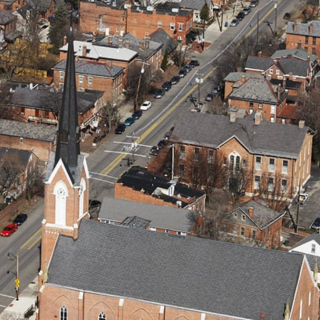With family and community support, Edith Espinal is striving to keep her spirits up as she lives in sanctuary at the Columbus Mennonite Church to evade a deportation order. But immigration enforcement is doing what it can to make sanctuary feel like incarceration.
Espinal was notified in mid-August that she was slated for deportation. Since then she has been forced to wear an ankle bracelet GPS monitor that tracks her location. The monitor is owned and managed by GEO Group, a private company that contracts its correctional and detention services to Immigration and Customs Enforcement (ICE).
GEO Group gave generously to Donald Trump's presidential campaign. Despite numerous lawsuits for wrongful death, terrible living conditions, and violating anti-slavery laws in its detention centers, GEO Group was awarded another lucrative federal contract after Trump was elected.
Ankle bracelet monitoring “is becoming a common practice for people with no criminal offense,” said immigrant justice community organizer Rubén Herrera, who is supporting Espinal. “It used to be standard only for criminals.” Being present in the U.S. without documentation is a civil (not criminal) offense.
Wearing an ankle monitor 24 hours a day is intrusive to say the least. But at the end of October, GEO Group began to escalate Espinal’s discomfort level. The ankle bracelet began beeping and vibrating every weekday morning before 6 o’clock. On Saturday, November 11, it escalated further. Espinal started getting “wake-up calls” from the monitor on weekends, too.
“I don’t understand why they’re doing it,” Espinal said. “They know I’m here. They’re probably doing it to harass me, to push me to move out of sanctuary.” ICE agents have a long-standing policy against raiding churches and other “sensitive locations” to detain undocumented immigrants without the approval of a designated supervisor.
Espinal’s attorney asked a representative of GEO Group why her ankle monitor is making noise and vibrating every morning. The representative did not give a reason, saying only, “If she wants it off, she has to come in.”
Having constructive ways to occupy her time is helping Espinal to stay the course. “The church members here have been very helpful,” she said. “They are including me in classes, so I have someone who is teaching me how to sew and to knit. I walk and do exercise with the staff here. I was also asked to make little angels as props for a Christmas play that the children are going to perform here.” Espinal also gets visits from friends in the immigrant community.
Columbus Mayor Andrew Ginther has been invited to visit Espinal in sanctuary; there are high hopes that he will come. Espinal has also requested visits from Governor John Kasich and Ohio Senators Rob Portman and Sherrod Brown. “I would like to encourage people to contact the Governor and Senators to visit me and hear my story,” she said.
“She’s leading the movement for immigrant justice,” said Rubén Herrera. “She’s putting the Mayor’s words into action. Edith and other people in sanctuary are the only resistance movement right now against deportations.”
Espinal is one of three undocumented immigrants in Ohio who are in sanctuary. There are currently 32 public sanctuary cases in the U.S.



